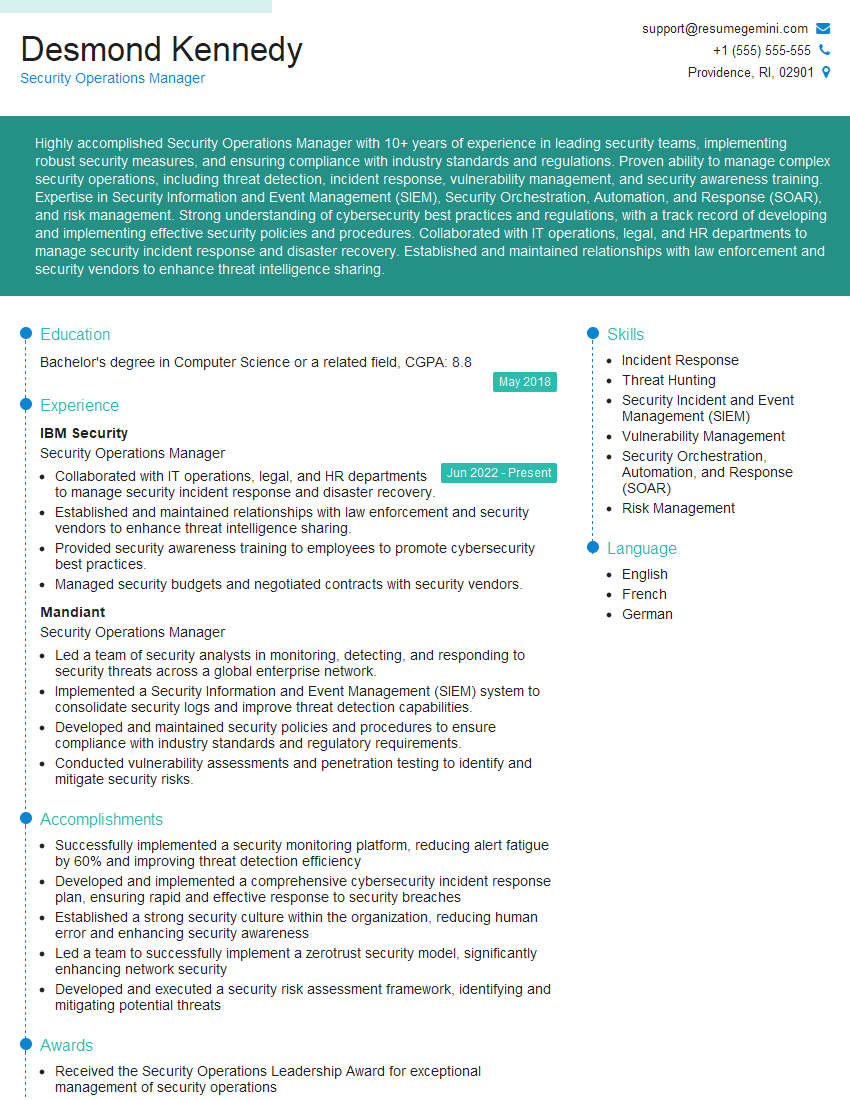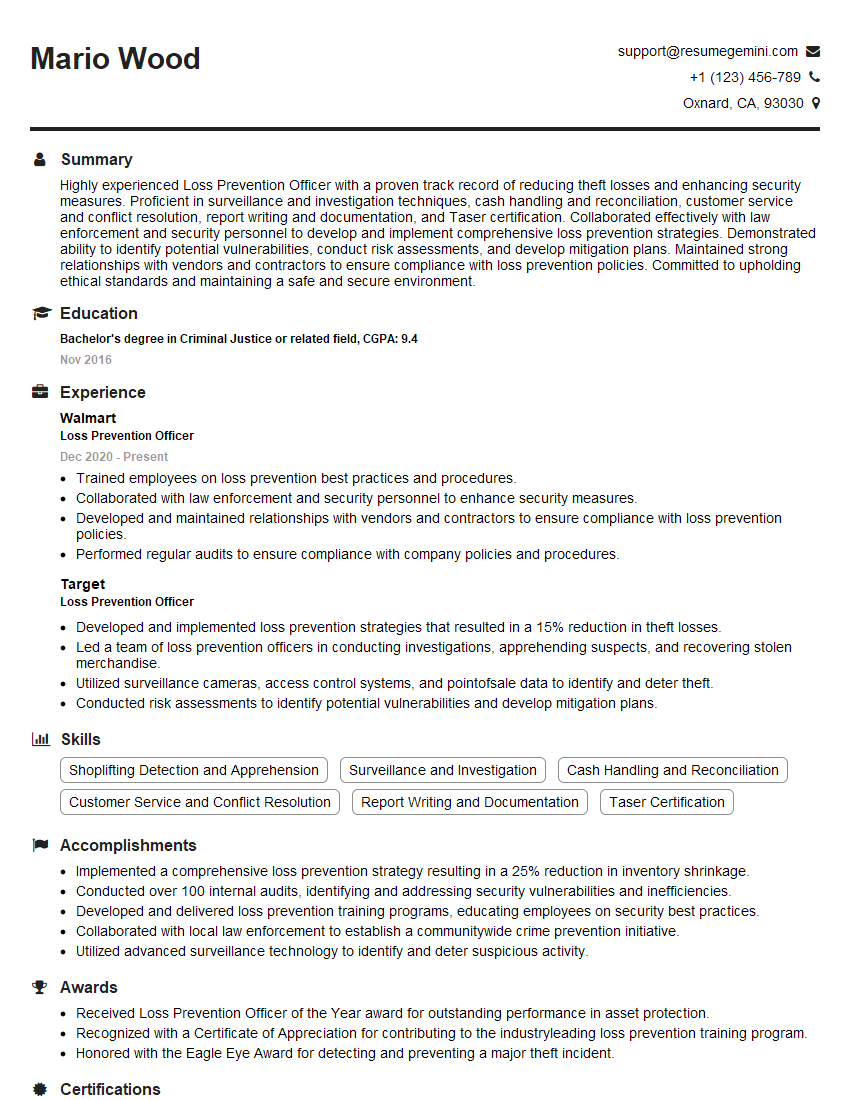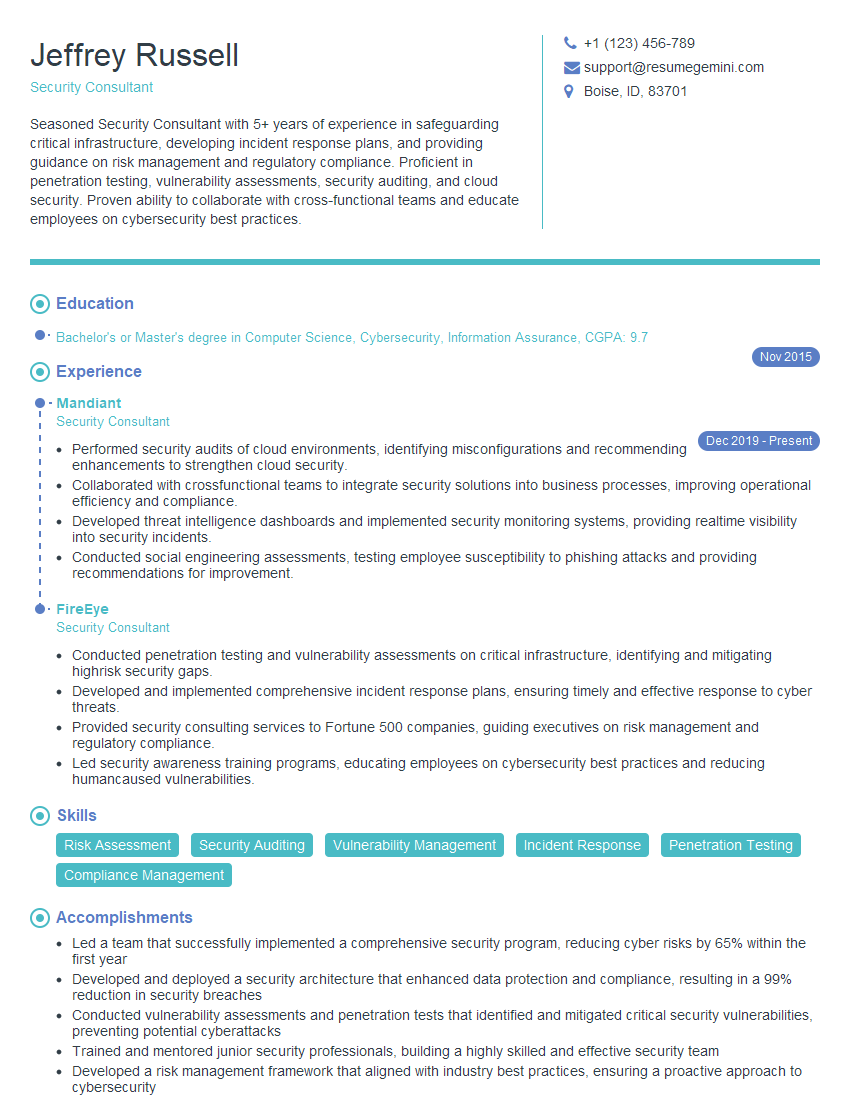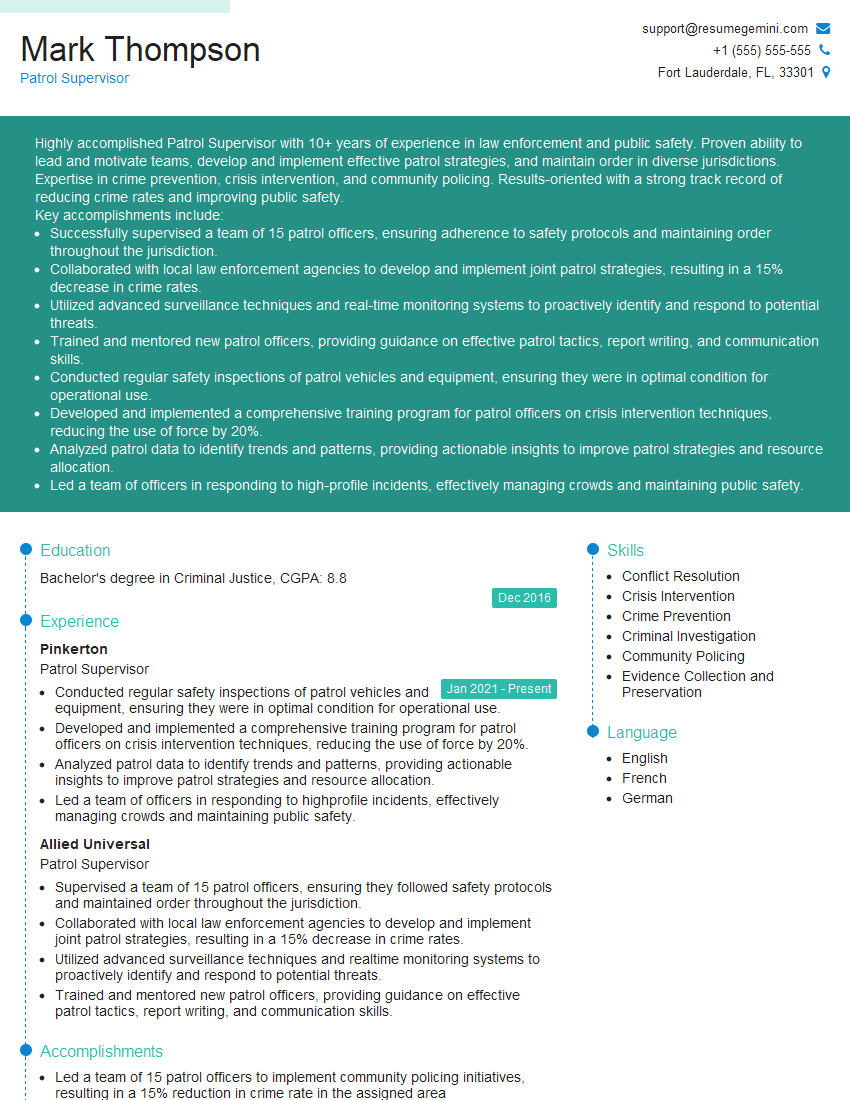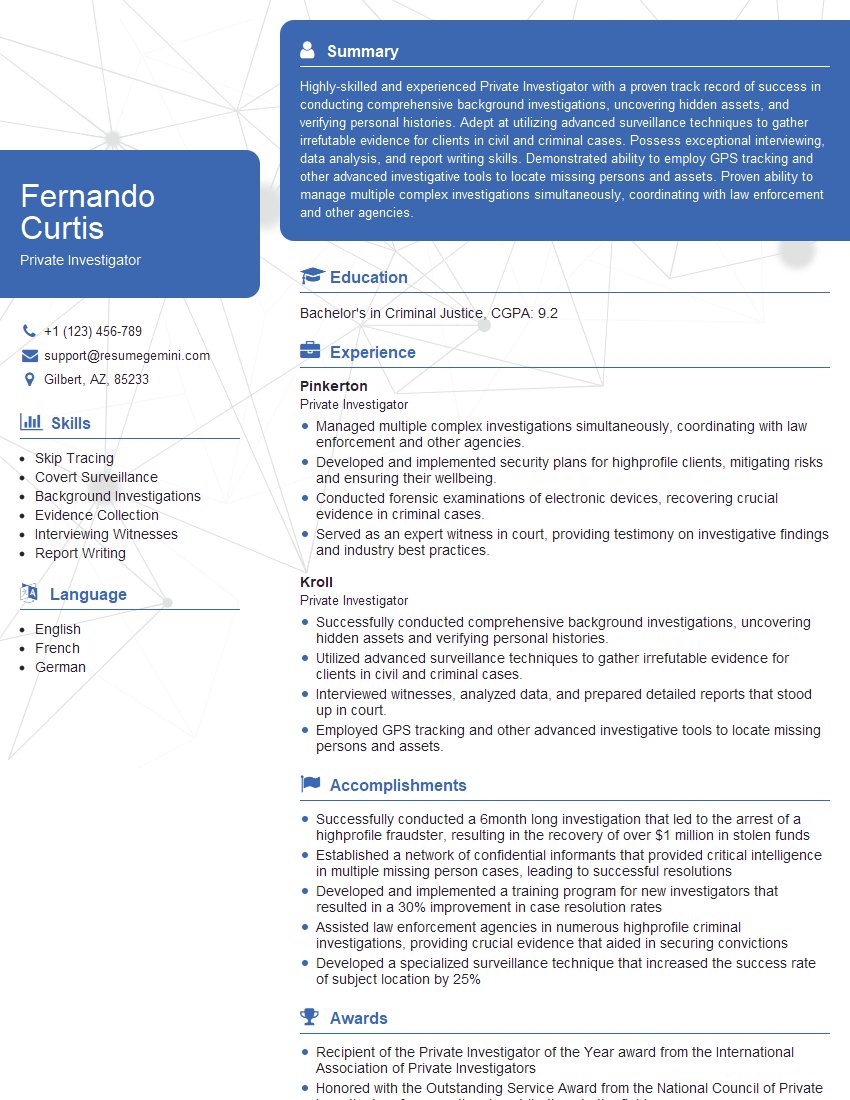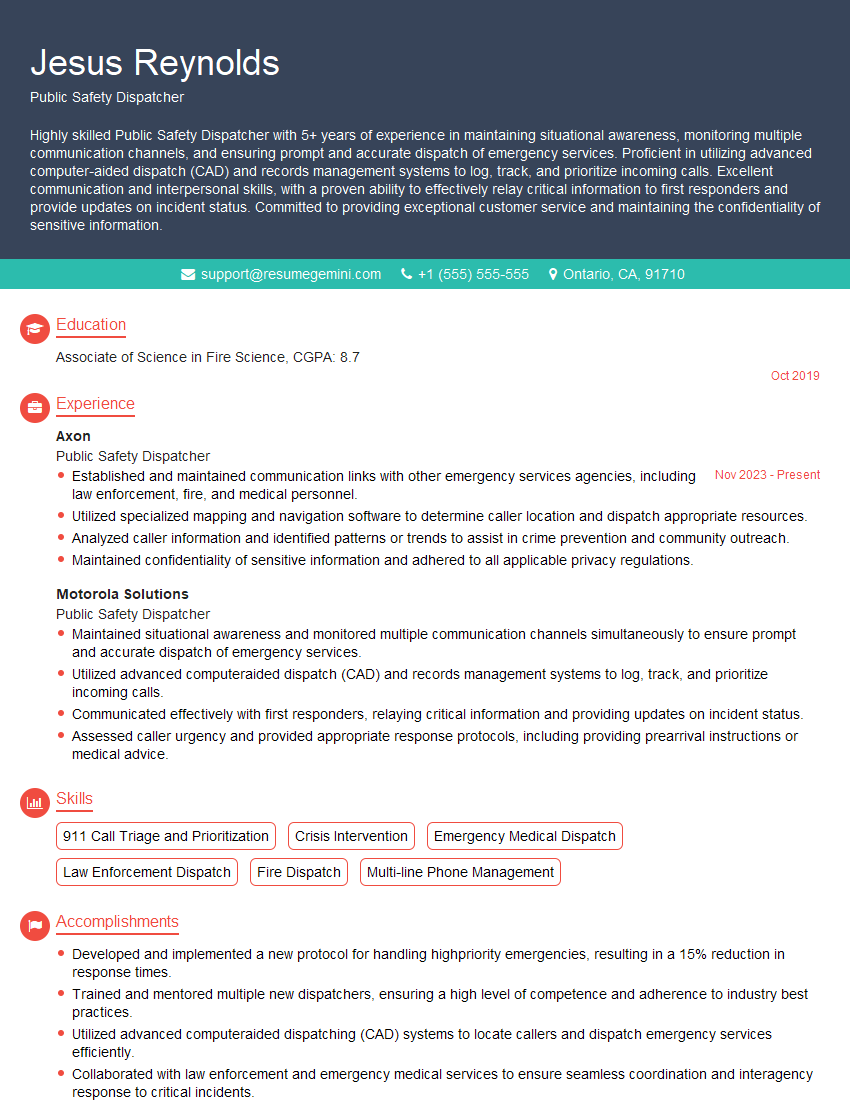The thought of an interview can be nerve-wracking, but the right preparation can make all the difference. Explore this comprehensive guide to Patrol Planning and Execution interview questions and gain the confidence you need to showcase your abilities and secure the role.
Questions Asked in Patrol Planning and Execution Interview
Q 1. Explain your understanding of patrol route optimization techniques.
Patrol route optimization is crucial for maximizing efficiency and coverage. It involves strategically planning patrol routes to cover designated areas effectively, minimizing travel time and maximizing the visibility of patrol officers. Several techniques can be employed, including:
- Shortest Path Algorithms: Algorithms like Dijkstra’s algorithm or A* search can determine the shortest route between points, minimizing travel time. Imagine a scenario with multiple checkpoints – these algorithms ensure officers cover all checkpoints in the least amount of time.
- Geographic Information Systems (GIS): GIS software allows for visualizing patrol areas, identifying high-risk zones, and plotting optimal routes considering factors like road networks and geographical features. For instance, GIS can identify the most efficient way to patrol a large campus, considering building locations and pedestrian pathways.
- Beat Optimization: This involves dividing the patrol area into beats and assigning routes to each beat based on crime statistics, population density, and other relevant factors. Think of a city divided into districts – each district would have a tailored patrol route based on its unique needs.
- Simulated Annealing and Genetic Algorithms: These advanced optimization techniques are used for more complex scenarios with many constraints, such as multiple officers with varying capabilities or time windows for patrol activities. This approach is particularly useful in scenarios where constraints like traffic patterns and officer availability are significant factors.
The selection of the optimal technique depends on the specific context, available resources, and the complexity of the patrol area.
Q 2. How do you prioritize patrol areas based on risk assessment?
Prioritizing patrol areas based on risk assessment is critical for effective resource allocation. It involves a multi-step process:
- Data Collection: Gather data on crime rates, incident reports, historical crime patterns, and intelligence reports from various sources.
- Risk Analysis: Analyze the data to identify high-risk areas, considering factors like type of crime, frequency, time of day, and location.
- Risk Scoring: Assign a risk score to each area based on the severity and likelihood of incidents. A weighted system can be used, assigning higher weights to more serious crimes.
- Resource Allocation: Allocate patrol resources proportionally to the risk scores. High-risk areas should receive more frequent and intensive patrols.
- Regular Review: Regularly review and update the risk assessment and patrol prioritization based on new data and changing circumstances.
For example, an area with a high number of burglaries during evening hours will receive more patrols during that specific time frame compared to an area with fewer incidents. This ensures effective deployment of patrol officers where they are needed most.
Q 3. Describe your experience in developing patrol schedules.
Developing patrol schedules involves careful consideration of various factors to ensure adequate coverage and officer well-being. My approach includes:
- Needs Assessment: Determining the required patrol coverage based on area size, population density, risk assessment, and available resources.
- Shift Planning: Scheduling shifts to ensure continuous coverage throughout the day and night, considering officer availability and rest periods.
- Route Assignment: Assigning specific patrol routes to officers, optimizing for travel time and coverage efficiency. This also involves considering officers’ experience levels and individual capabilities.
- Flexibility: Building flexibility into the schedule to accommodate unexpected events or changing circumstances. This might involve pre-defined contingency plans or the ability to reassign officers quickly.
- Communication: Ensuring clear communication of the schedule to all officers, including clear instructions, maps, and contact information.
- Feedback Mechanism: Establishing a feedback loop to gather input from officers about the schedule’s effectiveness and make necessary adjustments.
In a previous role, I developed a rota system using a spreadsheet and GIS mapping software to optimize patrol schedules for a large shopping mall, ensuring sufficient coverage throughout peak hours and considering the mall layout and security vulnerabilities.
Q 4. What software or tools have you used for patrol planning and tracking?
I have extensive experience using various software and tools for patrol planning and tracking. These include:
- Geographic Information Systems (GIS) software: ArcGIS and QGIS for visualizing patrol areas, plotting routes, and analyzing crime data.
- Computer-Aided Dispatch (CAD) systems: These systems provide real-time information on calls for service, officer locations, and other critical data, aiding in dynamic patrol adjustments.
- Mobile Data Terminals (MDTs): In-vehicle computers that provide officers with access to real-time information, allowing for efficient response to incidents and enhanced communication with dispatch.
- Patrol Planning Software: Specialized software for optimizing patrol routes, managing schedules, and tracking officer performance. Examples include various proprietary solutions tailored to law enforcement.
- GPS Tracking Systems: These provide real-time location data for patrol vehicles and officers, enhancing supervision, accountability, and response times.
The choice of software and tools depends heavily on the specific needs and resources of the organization.
Q 5. How do you ensure effective communication between patrol officers and dispatch?
Effective communication between patrol officers and dispatch is paramount for efficient patrol operations and rapid response to incidents. I ensure this through:
- Clear Communication Protocols: Establishing standardized procedures for reporting incidents, requesting assistance, and providing updates to dispatch.
- Regular Training: Providing regular training to both officers and dispatchers on communication protocols and the use of communication technology.
- Reliable Communication Systems: Utilizing reliable two-way radios, mobile data terminals (MDTs), and other communication technologies.
- Situational Awareness: Dispatchers maintain constant situational awareness of officer locations and activities, enabling proactive support and rapid response.
- Feedback Mechanisms: Creating channels for feedback from both officers and dispatchers to identify areas for improvement in communication procedures.
For example, the use of standardized codes for incident types facilitates rapid understanding and response from dispatch, minimizing delays during critical situations.
Q 6. Explain your process for handling unexpected incidents during a patrol.
Handling unexpected incidents during a patrol requires a structured and decisive approach:
- Assess the Situation: Quickly assess the nature and severity of the incident, ensuring officer safety and the safety of others.
- Prioritize: Prioritize actions based on the urgency and potential risk to life and property. Immediate threats require immediate action.
- Request Backup: If necessary, immediately request backup from other officers or emergency services.
- Secure the Scene: Secure the scene to prevent further harm or the destruction of evidence, maintaining the safety of all involved.
- Gather Information: Gather information from witnesses, victims, and suspects, following proper procedures for evidence collection.
- Report the Incident: Provide a detailed report to dispatch, including location, type of incident, and actions taken.
- Follow-Up: Follow established procedures for follow-up investigations and paperwork.
In a past experience, I responded to an unexpected car accident while on patrol. My immediate actions involved securing the scene, requesting medical assistance, and coordinating with traffic control to minimize disruptions. This prioritized the safety of all involved while maintaining the integrity of the investigation.
Q 7. How do you adapt patrol plans to changing circumstances (e.g., weather, events)?
Adapting patrol plans to changing circumstances, such as weather events or special events, is crucial for maintaining safety and effectiveness. This involves:
- Monitoring Conditions: Continuously monitoring weather forecasts, event schedules, and other relevant information that might affect patrol operations.
- Dynamic Replanning: Adjusting patrol routes and schedules based on real-time conditions. For example, during severe weather, patrols might focus on ensuring road safety and responding to weather-related incidents.
- Resource Re-allocation: Re-allocating resources to address areas affected by the change in circumstances. This may require shifting officer assignments or deploying additional resources.
- Communication: Keeping officers informed of changes to patrol plans and providing clear instructions on how to handle the new circumstances.
- Contingency Planning: Developing contingency plans for different scenarios, such as power outages or large-scale events, to ensure preparedness and response capabilities.
During a major public event in my previous role, we adapted our patrol plan by increasing officer presence in high-traffic areas, establishing designated traffic control points, and coordinating with event organizers for improved communication and safety.
Q 8. What are the key performance indicators (KPIs) you use to measure patrol effectiveness?
Measuring patrol effectiveness requires a multi-faceted approach using several Key Performance Indicators (KPIs). We don’t rely on a single metric, but rather a combination to gain a holistic view. Think of it like assessing a team’s performance in a sport – you need to consider goals scored (responses to calls), assists (preventative patrols), and overall game strategy (route optimization).
- Response Time: This measures the time it takes for officers to arrive at an incident scene. A shorter response time directly translates to faster assistance and potentially better outcomes. We track this diligently and analyze trends to identify potential bottlenecks.
- Crime Rate Reduction: This is a key indicator of overall patrol effectiveness. We monitor crime statistics in areas under patrol, comparing data before and after implementing specific patrol strategies. A decrease indicates successful crime deterrence.
- Citizen Satisfaction: We regularly solicit feedback from the community through surveys and informal interactions. Positive feedback reflects satisfaction with patrol responsiveness and presence.
- Officer Safety Incidents: Tracking incidents like assaults or near-miss accidents provides crucial information for identifying high-risk areas and refining safety protocols. This is paramount.
- Proactive Enforcement: We monitor the number of proactive stops, citations issued, and arrests made to gauge the effectiveness of preventative policing initiatives. This shows the effectiveness of patrolling beyond just responding to emergencies.
By analyzing these KPIs, we identify areas for improvement and refine our patrol strategies to maximize effectiveness and resource allocation.
Q 9. How do you manage patrol officer workloads and ensure adequate coverage?
Managing patrol officer workloads and ensuring adequate coverage is a complex balancing act. It requires a deep understanding of both staffing levels and crime patterns. We use a combination of strategies to optimize workloads and coverage.
- Data-Driven Scheduling: We analyze historical crime data, call frequency, and other relevant information to create dynamic patrol schedules. This ensures officers are deployed strategically to high-risk areas during peak times.
- Geographic Information Systems (GIS): We utilize GIS mapping to visualize crime hotspots, patrol routes, and officer locations. This enables real-time adjustment of patrols based on dynamic situations.
- Beat Management: We assign officers to specific beats or zones, ensuring consistent coverage of assigned areas and building relationships within the community. Regular beat assessments ensure routes are effective.
- Flexible Staffing: We have a system for deploying additional officers to high-activity areas during critical times, such as large events or significant crime spikes. This proactive approach avoids overburdening officers in lower-activity areas.
- Technology Integration: We use patrol management software that helps in assigning tasks, tracking officer location, and managing resources optimally. This provides a comprehensive overview of the situation and enables efficient resource allocation.
Regular evaluation and adjustment of these strategies is crucial to ensure fair workload distribution and optimal coverage. We constantly monitor officer feedback and make adjustments as needed.
Q 10. Describe your experience with GPS tracking and its use in patrol management.
GPS tracking has revolutionized patrol management. It’s moved from a simple tool for tracking location to an integral part of our operational efficiency and officer safety. We use GPS data in several ways:
- Real-time Tracking: We can monitor the location of all patrol units in real-time, allowing for rapid response to emergencies or re-allocation of resources during critical situations.
- Route Optimization: We analyze GPS data to identify inefficiencies in patrol routes, allowing for the creation of more efficient and effective patrol patterns. This saves time and resources, enhancing coverage.
- Performance Monitoring: GPS data helps us monitor officer adherence to scheduled routes and identify deviations. This isn’t about micromanagement, but ensuring coverage and responding to unexpected events.
- Incident Response: In an emergency, the precise location of an officer can be instantly relayed to dispatch, facilitating faster emergency response.
- Officer Safety: GPS tracking provides a safety net. If an officer is in distress, their location can be immediately identified and assistance dispatched.
It’s crucial to balance the benefits of GPS tracking with concerns around officer privacy. We adhere to strict privacy policies and ensure officers are informed about data usage and protocols.
Q 11. How do you conduct a post-patrol debriefing?
Post-patrol debriefings are a critical component of continuous improvement and maintaining a cohesive team. These aren’t mere formalities; they’re opportunities for learning and growth. Our debriefs follow a structured format:
- Review of Events: Officers briefly recount significant events, incidents, or observations from their patrols. This can include anything from traffic stops to suspicious activity.
- Problem Identification: We identify any challenges faced during the patrol, including procedural difficulties, equipment malfunctions, or safety concerns. This allows for addressing specific problems immediately.
- Best Practices Sharing: Officers share successful strategies, problem-solving techniques, and any lessons learned during their shifts. This fosters collaboration and continuous improvement.
- Safety Review: We discuss safety incidents or near misses. This is an opportunity for identifying potential hazards and improving safety protocols.
- Feedback and Coaching: We provide constructive feedback, offering guidance and coaching based on observations and performance. We emphasize a supportive and collaborative environment.
By actively participating in these debriefings, officers contribute to a culture of learning and continuous improvement, leading to a safer and more efficient patrol operation.
Q 12. How do you identify and address patrol route inefficiencies?
Identifying and addressing patrol route inefficiencies is a continuous process. We employ a combination of methods:
- GPS Data Analysis: We analyze GPS data to identify areas where patrols spend excessive time or have insufficient coverage. This analysis helps us refine routes to maximize efficiency.
- Crime Mapping: By overlaying crime data onto patrol routes, we can identify areas where patrols are insufficient and adjust accordingly. This is a vital link between intelligence gathering and response.
- Officer Feedback: We solicit feedback from patrol officers regarding route challenges, traffic congestion, or areas requiring more attention. Their on-the-ground experience is invaluable.
- Simulation and Modeling: We utilize patrol route optimization software to simulate different patrol routes and identify the most efficient patterns. This allows for testing before implementation.
- Regular Route Reviews: We conduct regular reviews of existing patrol routes to ensure they remain effective and adapt to changing crime patterns and community needs.
By using these methods, we ensure that our patrol routes are optimized for both efficiency and effectiveness, maximizing the impact of our patrol resources.
Q 13. What are your strategies for ensuring officer safety during patrols?
Ensuring officer safety is paramount. Our strategies are multifaceted:
- Training: We provide comprehensive training on defensive tactics, situational awareness, and de-escalation techniques. Regular refresher courses keep skills sharp.
- Equipment: Officers are equipped with the latest technology, including body cameras, tasers, and high-visibility vests. Regular equipment checks ensure functionality.
- Partnerships: We collaborate with other agencies and community groups to share information and coordinate efforts. This collaborative approach strengthens response capabilities.
- Risk Assessment: We conduct regular risk assessments of patrol areas to identify potential hazards and adjust patrol strategies accordingly. This proactive assessment minimizes risks.
- Communication: We emphasize clear and consistent communication between officers and dispatch. Real-time communication enables rapid response to emergencies and strengthens support networks.
- Peer Support: We foster a strong sense of camaraderie and peer support among officers, providing emotional support and reducing feelings of isolation. This strengthens the psychological safety of the officers.
Officer safety is not just a policy; it’s a culture. We continuously refine our strategies to ensure our officers return home safe every day.
Q 14. How do you handle conflicts or disagreements among patrol officers?
Conflicts among patrol officers are inevitable in a high-pressure environment. Our approach emphasizes timely intervention and resolution:
- Open Communication: We encourage open communication and create a culture where officers feel comfortable expressing concerns. This addresses problems before they escalate.
- Mediation: For minor disagreements, we employ mediation techniques to help officers resolve conflicts constructively. This promotes mutual understanding and problem-solving.
- Formal Investigation: For serious conflicts or allegations of misconduct, we conduct thorough investigations following established procedures. This ensures fairness and accountability.
- Training on Conflict Resolution: We provide training on conflict resolution and communication skills, equipping officers with the tools to manage disagreements effectively. This is a crucial skillset for law enforcement officers.
- Supervisory Oversight: Supervisors provide ongoing support and guidance to address conflicts proactively. This direct intervention prevents issues from escalating.
Our aim is to create a positive and supportive work environment where conflicts are resolved fairly and efficiently, maintaining team cohesion and morale. The focus remains on upholding professional conduct and delivering effective policing.
Q 15. Explain your experience in using patrol reporting software.
My experience with patrol reporting software spans several systems, from basic spreadsheet-based solutions to sophisticated, integrated platforms. I’m proficient in using software to track patrol routes, record incidents, manage officer schedules, and generate comprehensive reports. For instance, in my previous role, we utilized a system called ‘Guardian Patrol,’ which allowed real-time tracking of officers, automated incident reporting, and the creation of customized reports for analysis. This system significantly improved our efficiency and provided valuable data for optimizing patrol strategies. I’m also familiar with features like GPS integration for accurate location tracking, digital evidence management, and data export capabilities for integration with other systems. The key to effective use is understanding the specific capabilities of the software and tailoring its use to meet the unique needs of the patrol operation. Learning a new system is straightforward for me; I focus on understanding the underlying logic and quickly master the user interface.
Career Expert Tips:
- Ace those interviews! Prepare effectively by reviewing the Top 50 Most Common Interview Questions on ResumeGemini.
- Navigate your job search with confidence! Explore a wide range of Career Tips on ResumeGemini. Learn about common challenges and recommendations to overcome them.
- Craft the perfect resume! Master the Art of Resume Writing with ResumeGemini’s guide. Showcase your unique qualifications and achievements effectively.
- Don’t miss out on holiday savings! Build your dream resume with ResumeGemini’s ATS optimized templates.
Q 16. How do you maintain accurate and up-to-date patrol records?
Maintaining accurate and up-to-date patrol records is paramount for operational efficiency and accountability. My approach involves a multi-pronged strategy. First, real-time data entry is crucial. Officers are trained to record details immediately after an event, avoiding the risk of forgotten information. Second, regular data verification is essential. I implement a system of supervisors reviewing patrol reports for completeness and accuracy. This involves cross-checking information against other sources, like security camera footage or witness statements. Third, the use of technology is vital. Patrol reporting software with automated data validation features helps identify inconsistencies and errors early on. Fourth, training is continuous. Officers receive regular updates on reporting procedures and best practices. Finally, a robust record-keeping system, both physical and digital, with secure backup ensures data integrity and accessibility. Think of it like a meticulous accounting system – every transaction (in this case, patrol activity) must be recorded, verified, and archived securely.
Q 17. Describe your experience with incident reporting and documentation.
Incident reporting and documentation are critical for legal compliance and effective investigation. My experience encompasses all aspects, from initial response to final report generation. I’ve handled a wide range of incidents, from minor disturbances to serious crimes. My approach emphasizes thoroughness and accuracy. This involves detailed descriptions of the incident, including time, location, individuals involved, and relevant evidence. I understand the importance of objective reporting, avoiding subjective opinions or assumptions. Photographs, videos, and witness statements are meticulously documented and securely stored. I’m also proficient in using various reporting formats and adhering to specific legal requirements. For example, in a case of assault, the report would include detailed injury descriptions, statements from witnesses and victims, and any collected physical evidence. Clear, concise, and accurate documentation ensures the integrity of the investigation and protects both the agency and the individuals involved. My experience includes training officers on proper incident reporting techniques, emphasizing the importance of clear and unbiased documentation.
Q 18. What is your approach to training new patrol officers?
Training new patrol officers is a structured process that combines classroom instruction and practical field experience. It starts with a comprehensive overview of departmental policies, procedures, and legal frameworks. Then, officers receive hands-on training in patrol techniques, including observation skills, communication strategies, and proper use of equipment. We utilize role-playing exercises to simulate real-life scenarios, fostering critical thinking and problem-solving abilities. Emphasis is placed on de-escalation techniques and safe interaction with the public. Mentorship is a core component. Experienced officers guide newcomers, providing ongoing support and feedback. Regular performance evaluations and feedback sessions help identify areas for improvement and ensure continuous skill development. The training program mimics a progressive learning curve, starting with basic patrol skills and gradually increasing complexity, building confidence and competence.
Q 19. How do you evaluate the performance of patrol officers?
Evaluating patrol officer performance is a holistic process that considers multiple factors. We use a combination of quantitative and qualitative measures. Quantitative measures include statistics on response times, number of incidents handled, and adherence to patrol routes. Qualitative measures involve supervisor observations, peer reviews, and self-evaluations. Feedback is provided regularly, both positive and constructive. We also track officer participation in training programs and professional development activities. Performance evaluations are used for improvement planning and identifying officers who demonstrate exceptional skill and dedication. The goal is not just to assess performance, but also to identify strengths and weaknesses and provide support for professional growth. A balanced scorecard approach helps to avoid focusing solely on numbers while still recognizing the importance of efficient and effective patrol operations.
Q 20. What are the legal and ethical considerations for conducting patrols?
Legal and ethical considerations are paramount in conducting patrols. Officers must be thoroughly trained on constitutional rights, including the Fourth Amendment’s protection against unreasonable searches and seizures. Understanding the limits of authority and the proper use of force is crucial. Maintaining objectivity and impartiality in all interactions is essential, avoiding bias based on race, religion, or other factors. Strict adherence to departmental policies and procedures is necessary to ensure legal compliance. Regular updates on relevant laws and legal precedents keep officers informed and prepared. Transparency and accountability are fundamental. All actions must be documented thoroughly and accurately. Ethical considerations include treating all individuals with respect, even those suspected of wrongdoing. Acting with integrity and maintaining public trust are vital aspects of effective and responsible patrolling. Regular review and updates of policies and training programs are essential to ensure legal and ethical compliance.
Q 21. How do you ensure compliance with company policies and procedures?
Ensuring compliance with company policies and procedures requires a multi-faceted approach. First, clear and accessible communication is essential. Policies must be well-defined and easily understood by all officers. Regular training sessions and updates keep officers informed of any changes or modifications. Second, a system of internal checks and balances is crucial. Supervisors review patrol records and reports to identify any deviations from policy. Third, a culture of compliance is fostered by promoting accountability and recognizing adherence to procedures. Fourth, mechanisms for reporting and addressing non-compliance are established, ensuring that any breaches are addressed promptly and effectively. These may include disciplinary actions, retraining, or policy revisions. Finally, regular audits and reviews ensure continuous monitoring and improvement of compliance processes. Compliance is not just a matter of following rules but also of understanding the reasons behind those rules and their importance in maintaining operational efficiency, public safety, and legal integrity.
Q 22. Describe your experience in using mobile patrol technology.
Mobile patrol technology has revolutionized security operations, and I have extensive experience utilizing various systems. This includes using mobile devices equipped with GPS tracking, incident reporting software, and two-way communication features. For example, in my previous role, we used a system where officers could log patrols, record incidents with photos and detailed descriptions, and receive real-time updates on priority areas or emergency calls directly on their tablets. This streamlined our response times significantly and provided detailed data for performance analysis. Another system I’ve worked with used geofencing capabilities, automatically triggering alerts if a patrol officer deviated from their designated route or lingered in an area for too long, enhancing officer safety and ensuring comprehensive coverage.
The benefits extend beyond efficiency. The data collected allows for meticulous analysis of patrol effectiveness, identifying potential security gaps or areas requiring increased attention. We could pinpoint crime hotspots, optimize patrol routes, and demonstrate the effectiveness of our patrols to stakeholders through quantifiable data.
Q 23. How do you integrate CCTV footage into your patrol planning and execution?
Integrating CCTV footage into patrol planning and execution is crucial for proactive security. Before a patrol begins, I review footage from relevant cameras to identify potential threats or areas of concern. This might include observing suspicious activity, identifying individuals who need to be monitored more closely, or assessing the current state of particular areas. For instance, before a night patrol, reviewing footage can reveal whether a certain gate is frequently left unlocked or if specific areas are prone to vandalism at night.
During the patrol, officers can use mobile devices to access live CCTV feeds. This enables immediate responses to incidents spotted on camera, allowing faster intervention and potentially preventing crimes. After patrol, reviewing the footage again allows us to verify patrol activities, ensuring that assigned areas were adequately covered and that any noted incidents were addressed appropriately. The footage also acts as valuable evidence for incident reports and investigations.
Q 24. How do you coordinate patrols with other security departments or agencies?
Effective coordination with other security departments and agencies is paramount for a comprehensive security strategy. I’ve utilized several methods to achieve this, including regular meetings, shared communication platforms, and joint training exercises. In one instance, we established a shared online communication system with local police, allowing for real-time updates on incidents, sharing of information on suspects, and seamless coordination of responses. For example, if an incident occurred near our facility’s perimeter, our team would instantly inform the local police, providing details such as suspect description and location. Similarly, we would actively engage with other security entities in the area to establish a unified approach to large-scale events or emergencies.
Establishing clear communication protocols and shared responsibilities is critical. This includes defining roles, escalation procedures, and methods of information sharing. The goal is to create a unified response, avoiding duplication of efforts and ensuring a coordinated response to any security threat.
Q 25. Explain your understanding of different patrol patterns (e.g., random, zone, etc.)
Patrol patterns are carefully selected based on the specific needs of the site and the nature of potential threats.
- Random Patrols: These are unpredictable and deter opportunistic crime, as criminals cannot anticipate patrol times or locations. However, they are less efficient for covering large areas systematically.
- Zone Patrols: The area is divided into zones, and each zone is patrolled systematically. This provides comprehensive coverage and allows for detailed observation within each zone. It is less effective in deterring crime that is highly mobile.
- Route Patrols: These follow a predetermined route, often used for high-traffic areas or when a visible security presence is desired. They are predictable, which is a drawback security-wise.
- Sector Patrols: A combination of zone and route patrols; this is the most versatile approach. For example, a large area could be divided into sectors, each with defined routes and zones within it.
The choice of pattern depends on factors like the size of the area, the type of security risks, and available resources. I often recommend a combination of patterns to maximize effectiveness and unpredictability.
Q 26. How do you mitigate the risks associated with lone patrols?
Lone patrols inherently carry higher risks. Mitigating these requires a multi-layered approach. This starts with thorough training on situational awareness, self-defense techniques, and emergency procedures. Officers should be equipped with personal emergency response systems (PERS) that provide immediate access to assistance. Regular check-ins with a central control room are crucial, with predefined frequencies based on the risk assessment of the area.
Technological solutions such as GPS tracking devices and body-worn cameras offer additional layers of safety, allowing real-time monitoring of officer location and providing evidence in case of an incident. Regular risk assessments of patrol routes and schedules are vital, identifying potential hazards and adjusting patrol plans accordingly. This may involve avoiding known high-risk areas during certain times or using buddy patrols in areas deemed particularly unsafe. Open communication channels and robust support systems are also essential, ensuring that officers feel supported and confident in their roles.
Q 27. Describe your experience with crisis management in a patrol context.
Crisis management during patrols demands swift, decisive action, and experience plays a significant role. My experience includes responding to various incidents, ranging from medical emergencies to active shooter situations. The key is to follow a structured approach, starting with immediate response, securing the scene, and then moving on to containment and resolution. The initial steps are critical: assessing the situation to determine the nature and extent of the threat, prioritizing immediate life-saving actions, and securing the area to prevent further harm. This is followed by communicating the situation effectively to relevant authorities and coordinating resources for an effective response. After immediate action, I focus on maintaining order, providing support to victims, and securing evidence for investigations.
Detailed incident reports and post-incident analysis are critical for continuous improvement. This allows us to identify areas for improvement in our response protocols and training, ensuring we are better prepared to handle future crises. After a major incident, a thorough debriefing is essential for officers involved, providing an opportunity to discuss experiences, process emotions, and learn from the event.
Key Topics to Learn for Patrol Planning and Execution Interview
- Patrol Route Optimization: Understanding factors influencing route planning (geographic considerations, crime statistics, resource allocation) and applying optimization techniques for efficient patrol coverage.
- Resource Allocation and Deployment: Practical application of strategies for allocating personnel and equipment effectively based on predicted demand and risk assessment. This includes understanding shift patterns and crew scheduling.
- Incident Response and Coordination: Developing effective protocols for responding to incidents, coordinating with other teams (emergency services, dispatch), and managing communication during critical events.
- Risk Assessment and Threat Analysis: Identifying high-risk areas, predicting potential threats, and integrating this analysis into patrol planning to proactively address vulnerabilities.
- Technology Integration: Understanding the role of technology in patrol planning and execution, including mapping software, crime analysis tools, and communication systems.
- Legal and Ethical Considerations: Adhering to legal guidelines, respecting individual rights, and maintaining ethical standards throughout the patrol planning and execution process.
- Performance Measurement and Evaluation: Understanding key performance indicators (KPIs) for patrol effectiveness, analyzing data to identify areas for improvement, and adapting strategies based on performance analysis.
- Communication and Teamwork: Effective communication strategies within the team and with other stakeholders, emphasizing collaboration and coordination for optimal results.
Next Steps
Mastering Patrol Planning and Execution is crucial for career advancement in law enforcement and security. It demonstrates your strategic thinking, problem-solving skills, and commitment to public safety. To significantly boost your job prospects, create an ATS-friendly resume that highlights your relevant skills and experience. ResumeGemini is a trusted resource that can help you build a compelling and effective resume. We provide examples of resumes tailored to Patrol Planning and Execution to guide you in crafting the perfect application. Invest time in building a strong resume—it’s your first impression with potential employers.
Explore more articles
Users Rating of Our Blogs
Share Your Experience
We value your feedback! Please rate our content and share your thoughts (optional).
What Readers Say About Our Blog
These apartments are so amazing, posting them online would break the algorithm.
https://bit.ly/Lovely2BedsApartmentHudsonYards
Reach out at [email protected] and let’s get started!
Take a look at this stunning 2-bedroom apartment perfectly situated NYC’s coveted Hudson Yards!
https://bit.ly/Lovely2BedsApartmentHudsonYards
Live Rent Free!
https://bit.ly/LiveRentFREE
Interesting Article, I liked the depth of knowledge you’ve shared.
Helpful, thanks for sharing.
Hi, I represent a social media marketing agency and liked your blog
Hi, I represent an SEO company that specialises in getting you AI citations and higher rankings on Google. I’d like to offer you a 100% free SEO audit for your website. Would you be interested?
